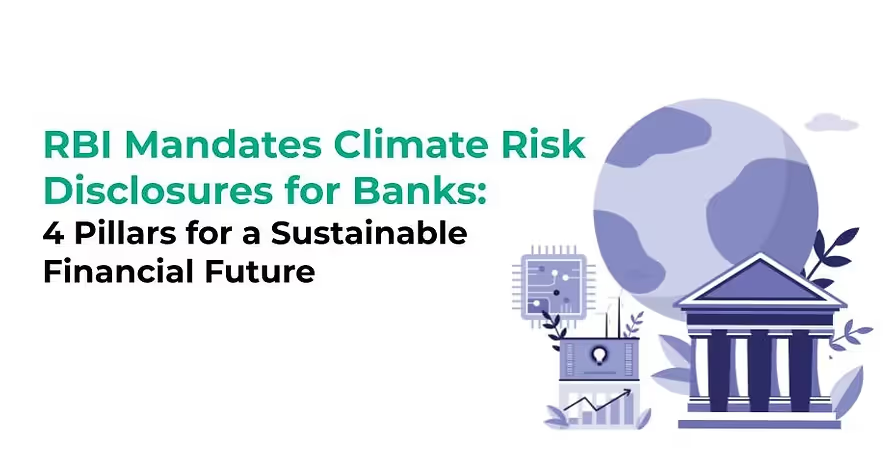
Solutions
Carbon Management
ESG Intelligence
Climate & Nature Risk
Data Registry
Beta
Sector
Get started, schedule a demo or request a free assessment!


The RBI's draft guidelines on climate-related financial disclosures represent a significant step towards building a more climate-resilient financial system in India. These guidelines aim to bring transparency and accountability to climate risks faced by the BFSI sector, and by mandating these, the RBI seeks to empower stakeholders with the information needed to make informed decisions and promote responsible financial practices.
This section focuses on how climate risk is integrated into the governance structure. It explores board oversight, management responsibility, and the integration of climate considerations into policies, strategies, and risk management frameworks.
1. Board Oversight: Does the Board have a dedicated committee or framework for overseeing climate-related risks and opportunities?
2. Management Responsibility: Who within the organization is accountable for managing climate risks? Are there designated roles and responsibilities?
3. Integration into Policies and Strategies: How are climate considerations factored into existing policies, strategies, and risk management frameworks?
Regulated entities are required to disclose their climate change strategy, encompassing how they identify, assess, and manage climate-related risks and opportunities over short, medium, and long terms, their impact on the business, strategy and financial planning. This includes details on scenario analysis, risk mitigation plans, and the alignment of their strategies with national and international climate goals.
1. Scenario Analysis: Does the entity conduct scenario analysis to understand the potential financial impacts of different climate change pathways?
2. Risk Mitigation Plans: What strategies are in place to mitigate identified climate risks? These could involve portfolio diversification, risk transfer mechanisms (e.g., insurance), or adjustments to lending practices.
3. Alignment with Climate Goals: How does the entity's strategy align with national and international climate goals, such as those outlined in the Paris Agreement?
The guidelines require disclosure of processes for identifying, assessing, and mitigating climate-related risks. This includes details on risk categorization, risk quantification methodologies, and capital allocation strategies.
1. Risk Categorization: How are climate risks categorized based on their severity and likelihood?
2. Risk Quantification Methodologies: What methodologies are used to quantify the potential financial impacts of climate risks? This could involve stress testing loan portfolios or insurance liabilities.
3. Capital Allocation Strategies: How is capital allocated to manage climate risks? Are there dedicated reserves or risk transfer mechanisms in place?
Measuring and reporting on climate-related impacts is essential for monitoring progress and ensuring accountability. The guidelines mandate the disclosure of relevant metrics aligned with international frameworks like the GHG Protocol. This includes details on greenhouse gas (GHG) emissions (Scope 1, 2 & 3), exposure to climate-vulnerable sectors, and the adoption of climate-resilient practices.
1. Greenhouse Gas (GHG) Emissions: How much greenhouse gas (GHG) emissions are generating across Scope 1, 2, and 3?
2. Climate Vulnerability Assessments: To what extent is the entity exposed to climate-vulnerable sectors within its lending portfolio or investment holdings?
3. Climate-Resilient Practices: What climate-resilient practices has the entity adopted within its own operations?
By implementing these proposed disclosures, the BFSI sector can enhance transparency, strengthen risk management, and unlock new opportunities for sustainable growth. The following section will explore the benefits of embracing these guidelines for the BFSI sector.
While the RBI's proposed guidelines offer significant benefits, implementing them may present some hurdles for the BFSI sector. Here's a closer look at these challenges:
These guidelines mark a significant step towards building a climate-resilient financial system in India. By fostering transparency, accountability, and responsible financial practices, the BFSI sector can play a pivotal role in building a future where finance and the environment go hand in hand. And while challenges exist, proactive implementation can lead to a more sustainable and resilient financial system, fostering long-term economic growth that considers environmental well-being.
The RBI's draft guidelines on climate-related financial disclosures represent a turning point for India's financial sector. By mandating transparency around climate risks and opportunities, the RBI empowers stakeholders to make informed decisions and steers the BFSI sector towards a more sustainable future. While challenges like data management and capacity building exist, proactive implementation can unlock long-term financial gains and position India's financial system at the forefront of global climate action. This framework paves the way for a future where environmental and financial well-being are no longer seen as competing priorities, but rather as two sides of the same coin.

.svg)